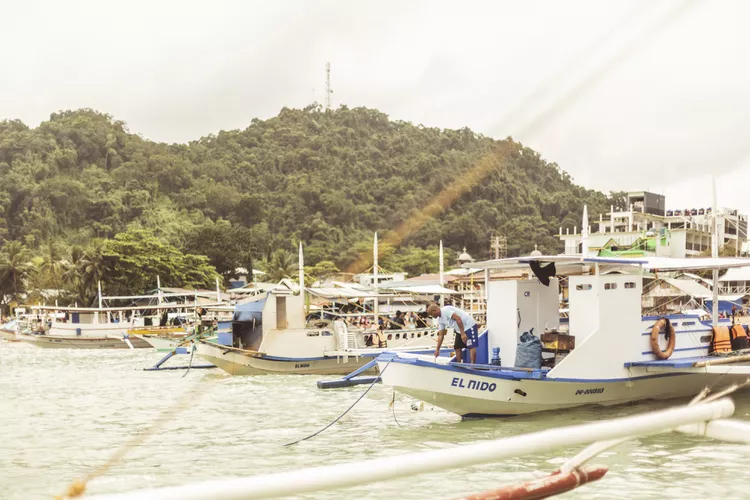Summary
The Philippines archipelago of El Nido is Paradise—with a few caveats. Take note of the tips below to ensure a smooth vacation in El Nido and Bacuit Bay.
When to Go to El Nido
El Nido is best seen during the months of November to May. In the first half of this period, cool northeast winds complement the sunny skies, allowing you to explore the islands in comfort. However, as the summer months of March and May set in, the heat increases; therefore, bring enough sunscreen to protect yourself.
Throughout these months (El Nido’s high tourist season), the sea is relatively calm, and underwater visibility is good, about ten to thirty feet.
The southwest monsoon from June to November brings the rainy season and reduced travel traffic. Consequently, while prices for all resorts and facilities are lower during the rainy season, the weather may be less cooperative: seas become choppy, and unpaved roads become muddier and more difficult to traverse.
What to Pack for your El Nido Trip
Bring light cotton clothing, and pack as lightly as possible if you’re flying there, as Air Swift (which flies into the local airport) has a 12kg limit on baggage. Moreover, dress modestly while you’re in town—Filipinos are still quite conservative in rural towns like El Nido, despite their constant interaction with Westerners.
While you’re in town, favor rubber flip-flops over shoes—the latter will just get in the way, as you’ll mostly be on the beach or jumping on and off pump boats between islands.
Snorkeling gear, diving gear, windsurfing gear, and kayaks can be rented in town.
Getting to El Nido
Getting to El Nido depends on your budget and appetite for adventure. Flying in is relatively effortless but can be costly. Alternatively, going overland from the capital of Puerto Princesa is the cheapest method, though it requires a tolerance for hours of travel over rough roads. Riding a boat depends entirely on weather conditions.
Getting Around El Nido
After your hotel stay, local transportation in El Nido is limited to the jeepney, but more commonly, the tricycle (a motorcycle with a covered sidecar attached). The fixed rate for tricycle travel within El Nido town is $0.20 (PHP 10).
If you want to travel further out, jeepneys provide town-to-town transport, while motorized vehicles can be hired from local providers. Motorbikes are a preferred mode of transport, as they can easily handle the area’s steeply inclined dirt trails.
Conservation Fee: A small conservation fee of $4 (PHP 200) per person will be collected by your tourist establishment for every night you stay. This fee goes to the El Nido Protected Area Management Board and is used to protect El Nido’s environment, offsetting any impact you make on the bay’s ecosystem.
Money and Foreign Exchange in El Nido
Bring as many Philippines pesos as you need—banks are nonexistent in El Nido, and there is a single ATM in town. Not all establishments accept credit cards, though one or two do surprisingly accept Paypal.
It is advisable to convert your money and travelers’ checks to the local currency at Puerto Princesa or in Manila before going to El Nido.
The El Nido Boutique and ArtCafe has a travel center that offers money changing services and credit card facilities, among other things.
The cost of meals and personal items is relatively low; expect to pay about $0.50 for a can of Coca-Cola™ and a decent meal will cost around $2-$4.
Electricity and Telecommunications in El Nido
El Nido is not yet fully electrified—the current runs from 3 pm to 3 am every day only, and most resorts have their own electric generators.
Cell sites for Philippines cellphone providers Smart and Globe are operational in El Nido, although Smart may have a slight advantage over Globe in terms of connectivity. If you possess a GSM phone, check with your provider if they have a roaming agreement with Smart or Globe.
Internet services are available throughout El Nido Town, with numerous internet cafes advertising their services along the main streets of Calle Real and Calle Hama.
Medical Facilities in El Nido
There are no hospitals in El Nido; a government-run Rural Health Unit provides healthcare for both the town and its visitors. The clinic’s doctor and his staff can manage minor health emergencies, but in major cases, you will need to travel to the provincial capital of Puerto Princesa.
A few local pharmacies can dispense common over-the-counter medicines like cough syrup and paracetamol. Therefore, it is wise to bring your own personal prescription drugs, as you’re unlikely to get your prescription filled in El Nido.
Malaria is endemic to Palawan, so consider bringing your choice of insect repellent and applying it regularly. Most El Nido rooms come with mosquito nets; therefore, ask for one if your room doesn’t have one.





